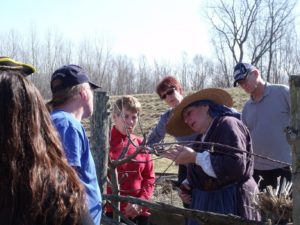 Welcome to the Jardin Potager outside the walls of Fort de Chartres! This garden has been planted in the style of a French l’habitant kitchen garden generally tended by the women of the Illinois Country. The accounts of the era remarked that the gardens contained a variety of the finest vegetables that were cultivated in raised beds, intermingled with herbs, flowers, and shrubs, located next to small orchards containing a variety of the choicest fruits. It was noted that l’habitants needed a substantial garden in order to be able to lay in a supply of vegetables and fruits for the winter months, along with the seasonal produce to be enjoyed during the growing season.
Welcome to the Jardin Potager outside the walls of Fort de Chartres! This garden has been planted in the style of a French l’habitant kitchen garden generally tended by the women of the Illinois Country. The accounts of the era remarked that the gardens contained a variety of the finest vegetables that were cultivated in raised beds, intermingled with herbs, flowers, and shrubs, located next to small orchards containing a variety of the choicest fruits. It was noted that l’habitants needed a substantial garden in order to be able to lay in a supply of vegetables and fruits for the winter months, along with the seasonal produce to be enjoyed during the growing season.
In deciding what to plant in the potager, related research was conducted and is ongoing, including time spent exploring period and handed down regional recettes (recipes). These recipes are so enlightening, as their ingredients would have been the basis of the vegetable and fruit choices cultivated. Heirloom seeds and plants have been planted to reflect the varieties that might have been cultivated mid18th century in the Illinois Country.
Located beyond the raised beds of the jardin potager, is a large garden area that is planted each season in late May with heirloom melons, watermelon, winter squash, and heritage corn.
Thank you to the Fort de Chartres Historic Site Staff, Les Amis de Fort de Chartres (The Friends of Fort de Chartres), KGI International, and individual donors for their financial and volunteer support of this heirloom garden project. Sincere thanks is offered to the many friends and volunteers who have assisted me and/or worked in the Fort de Chartres heritage garden project through the years.
Heirloom seed sources: Monticello Heirloom Seeds, Seeds Saver’s Exchange, Baker Creek Heirloom Seeds, Bountiful Gardens, Sustainable Seeds
To begin a journey exploring written accounts of the colonial French era, reference the writings of Henry Brackenridge, Nicolas de Finiels, Pehr Kalm, John Reynolds.
For further writings by modern historians regarding eighteenth century Illinois Country: Charles John Balesi, Margaret Kimball Brown, Carl J. Ekberg, John Francis McDermott, and John A. Walthall.
Vegetables & Fruits planted this season in the Jardin Potager:
Asparagus, Bush & Pole Bean, Beet, Cabbage, Carrot, Corn, Cucumber, Eggplant, Kale, Leek, Lettuce, Melon, Onion, Peas, Radish, Spinach, Summer and Winter Squash, Turnip, Watermelon
Please visit and like the Jardin’s FACEBOOK page for the latest Fort de Chartres Heritage Garden updates and events. One of the missions of this heritage garden is to share with the public heirloom sample seed packets to encourage exploration of the amazing vegetables, flowers, and herbs of the past.
Please visit us and watch this jardin grow!
Carol Kuntz,
Fort de Chartres Heritage Jardin Potager Project Curator & Volunteer
Questions? Please email me at heritage@fdcjardin.com.
Fort de Chartres State Historic Site Directions
The Fort’s jardin potager visitors have inquired if there was a place online to donate to this heritage garden project. A sincere thank you is owed to Les Amis du Fort de Chartres, for they have created a garden donation link that benefits the Fort de Chartres Heritage Garden Project. Many thanks to all who support this independent heritage garden project and its mission to share the rich French Colonial and Native Peoples foodway history and the heirloom seeds that illustrate and preserve this story. Merci, your support is gratefully appreciated! And don’t forget-my French Colonial Heritage Garden Seed Collections are available online at Les Amis du Fort de Chartres Heart of Illinois Artisan Heritage Shop.



Your site is a wonderful report and tourism attractive as is the real thing.
Ms. Kuntz:
One of the Jackson County Master Gardner sent me the link to your site. I am very impressed with what you have accomplished. I am interested in your upcoming events and come for a visit.
My Morrisseau family is supposed to be from Kaskaskia so this information on l’habitant garden is great. Love history like this.
I am very glad to have discovered this site. Thank you for your work on these gardens.
I love visiting the garden, it is so well tended and has been well-researched. It is an excellent example of what was grown during the period of the fort.
I’ve discovered recently through geneology done by my cousin that my ancestor, Alexander Duclos was in command at this fort in its early days. I’ve thoroughly enjoyed reading through your website and will certainly be visiting this fascinating historical site!